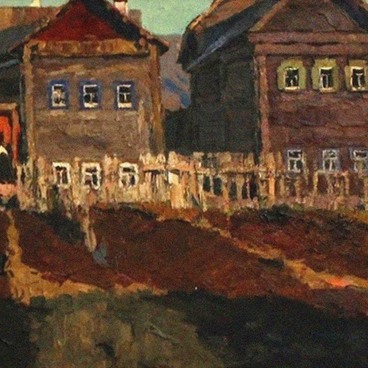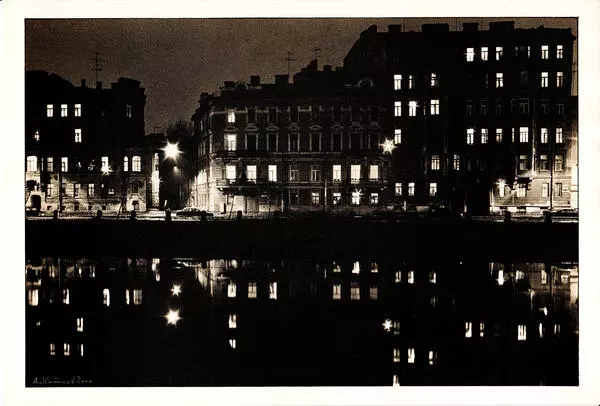The painting My Dear Child to the Periphery?! was presented at the All-Union Exhibition in 1954. After World War II, domestic art timidly outlined tendencies of critical realism, which, unfortunately, were not developed. One of the notable works of that genre was the work by Akhmet Kitaev, which modern criticism destroyed for the depiction of burghers’ way of life.
The essence of the scene depicted in the painting, in the next. In Soviet times university graduates were sent to remote villages or to the North regions, where they were to work for 3 years. Gradually young people grew strongly reluctant to leave big cities. Parents, who had the opportunity, tried in every way to get their children off the assigned employment. In the picture My Dear Child to the Periphery?! you can see the ending of the story: the father of the family failed to get off his daughter.
Soviet art historian A. A. Kamensky wrote a review published in the journal Art (No.12, 1955). The artist’s desire to address the problem was understandable to him. It is necessary to blame young people who are looking for easy ways. But the critic did not like the very approach of the artist to the topic. According to him, Kitayev savored ‘details of the carefully painted (burghers’) interior’ and the “scene of a routine family scandal.” According to Kamensky, the the painting narrated about the problem instead of exposing it. He did not appreciate the grotesque and clear irony in the depiction of the main characters.
That is despite the fact that the figure in the foreground of the picture is almost caricature. The bossy woman swings at her helpless husband with a ladle. Kamensky called her “an utterly vulgar female.” She is shouting at her husband, who has hopelessly covered his head with his hands. This is one part of the composition, which is contrasted with the other, in the right corner. There the artist depicted the compassionate grandmother who holds her granddaughter’s hand. And the very subject of the conflict resembles an actress who has theatrically dropped into a chair and pretends to be suffering because of the news of her assigned employment.
Akhmet Kitayev very skillfully conveyed the nature and temper of his heroes not only through characteristic postures, but also by means of colors. The red robe of the woman is a symbol of aggression. Her husband’s white shirt demonstrates his obedience and hopelessness. The grandmother’s flower-patterned purple dress is associated with kindness and peace of mind, which is so lacking in this family. The girl is dressed in a casually unbuttoned green cloak, and holds a fashionable handbag in her hand. In a sense she represents the ‘golden youth’ of the time. This mixture of colors further enhances the grotesque nature of everything that is going on.
The interior itself looks bourgeois, and it is difficult to disagree with A. Kamensky about this. But the artist’s own ironic attitude was appreciated only 40 years after the picture had been painted. An article about humor in art by L. Titov was published in 1996. It said that the picture was an “artistically staged farce about everyday troubles.” It should be perceived this way, without overloading it with excessive morality and didacticism.
The essence of the scene depicted in the painting, in the next. In Soviet times university graduates were sent to remote villages or to the North regions, where they were to work for 3 years. Gradually young people grew strongly reluctant to leave big cities. Parents, who had the opportunity, tried in every way to get their children off the assigned employment. In the picture My Dear Child to the Periphery?! you can see the ending of the story: the father of the family failed to get off his daughter.
Soviet art historian A. A. Kamensky wrote a review published in the journal Art (No.12, 1955). The artist’s desire to address the problem was understandable to him. It is necessary to blame young people who are looking for easy ways. But the critic did not like the very approach of the artist to the topic. According to him, Kitayev savored ‘details of the carefully painted (burghers’) interior’ and the “scene of a routine family scandal.” According to Kamensky, the the painting narrated about the problem instead of exposing it. He did not appreciate the grotesque and clear irony in the depiction of the main characters.
That is despite the fact that the figure in the foreground of the picture is almost caricature. The bossy woman swings at her helpless husband with a ladle. Kamensky called her “an utterly vulgar female.” She is shouting at her husband, who has hopelessly covered his head with his hands. This is one part of the composition, which is contrasted with the other, in the right corner. There the artist depicted the compassionate grandmother who holds her granddaughter’s hand. And the very subject of the conflict resembles an actress who has theatrically dropped into a chair and pretends to be suffering because of the news of her assigned employment.
Akhmet Kitayev very skillfully conveyed the nature and temper of his heroes not only through characteristic postures, but also by means of colors. The red robe of the woman is a symbol of aggression. Her husband’s white shirt demonstrates his obedience and hopelessness. The grandmother’s flower-patterned purple dress is associated with kindness and peace of mind, which is so lacking in this family. The girl is dressed in a casually unbuttoned green cloak, and holds a fashionable handbag in her hand. In a sense she represents the ‘golden youth’ of the time. This mixture of colors further enhances the grotesque nature of everything that is going on.
The interior itself looks bourgeois, and it is difficult to disagree with A. Kamensky about this. But the artist’s own ironic attitude was appreciated only 40 years after the picture had been painted. An article about humor in art by L. Titov was published in 1996. It said that the picture was an “artistically staged farce about everyday troubles.” It should be perceived this way, without overloading it with excessive morality and didacticism.



